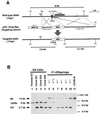Early embryonic lethality caused by targeted disruption of the mouse selenocysteine tRNA gene (Trsp)
- PMID: 9159106
- PMCID: PMC20812
- DOI: 10.1073/pnas.94.11.5531
Early embryonic lethality caused by targeted disruption of the mouse selenocysteine tRNA gene (Trsp)
Abstract
Selenoprotein biosynthesis is mediated by tRNASec, which inserts selenocysteine at UGA codons in a complex, context-specific manner. This opal suppressor serves in the conversion of serine to selenocysteine as well. The mouse tRNASec gene (Trsp) maps to a proximal segment of chromosome 7. We constructed mice carrying a targeted deletion of the Trsp gene. The heterozygous mutants were viable, fertile, and appeared normal. Although the level of tRNASec was reduced to about 50%-80% of the wild type in most organs, one of the selenoproteins, glutathione peroxidase, remained unaffected in the levels of its mRNA, protein, and enzyme activity, indicating that the haploid amount of tRNASec is not limiting in its biosynthesis. In contrast, the homozygous mutants died shortly after implantation, and the embryos were resorbed before 6.5 days post coitum. When the preimplantation embryos were placed in culture, however, the trophoectoderm cells showed outgrowths and the inner cell mass cells of the homozygous embryos were able to proliferate. These results indicate that Trsp expression is essential for early development of the embryo, and its lack causes peri-implantation lethality. However, the lethality does not appear to be due to a cell-autonomous function of tRNASec.
Figures



References
-
- Stadtman T C. Annu Rev Biochem. 1990;59:111–127. - PubMed
-
- Böck A. Trends Biochem Sci. 1991;16:463–467. - PubMed
-
- Stadtman T C. J Biol Chem. 1991;266:16257–16260. - PubMed
-
- Böck A, Forchhammer K, Heider J, Leinfelder W, Sawers G, Veprek B, Zinoni F. Mol Microbiol. 1991;5:515–520. - PubMed
-
- Stadtman T C. Annu Rev Biochem. 1996;65:83–100. - PubMed
MeSH terms
Substances
LinkOut - more resources
Full Text Sources
Other Literature Sources
Molecular Biology Databases

